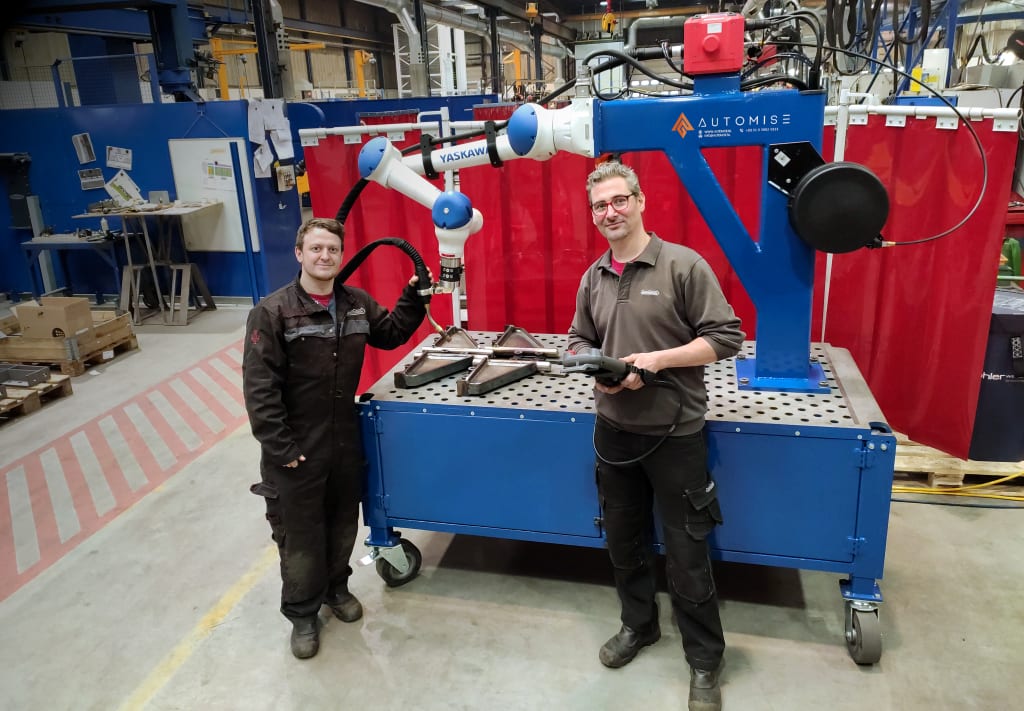Nooteboom Trailers B.V., family business founded in 1881, is an international company that offers its customers integral special transport models in the field of exceptional road transport. In order to be able to weld the many parts or steal constructions used in the trailers, Nooteboom Trailers has chosen to purchase a Yaskawa HC10 cobot from Automise B.V.
Cobot with the functionalities of a robot
Automise integrates Yaskawa HC10 cobot with the functionalities of a robot at Nooteboom Trailers
Automise is specialized in automating production processes. This may include providing personal and independent advice, developing welding jigs or robot tooling, or integrating software to program (welding) robots. It is also possible to have Automise program (welding) robots on- and offline or to train your own personnel in programming robots.
The collaboration between Nooteboom and Automise originates from the end of 2019, with the question whether Automise was willing to supply a cobot installation to weld trailer parts. A cobot or co-robot is a robot designed to work with humans in a shared work environment.
Smaller investment, big benefit
Nooteboom has chosen a Yaskawa HC10 cobot. The HC10 has all the functions that are also present in a normal welding robot. This allows searching and tracking of welds, multilayer welding and offline programming from a computer. In addition, it is possible to grab the cobot, put it in the right place and make programs in the cobot way. This is possible with the “Welding Wizard” application which comes standard with the HC10. With the Yaskawa HC10, Nooteboom has the ease of programming a cobot and the functionalities of a robot.
At Nooteboom Trailers, the cobot is mounted on a mobile workbench on the side of a steel column. The reach on the welding table is therefore optimal, but it is also possible to turn the steel column around and position the cobot above a product or trailer. This makes it possible to finish welding trailers per segment with the cobot, for which otherwise a large robotic system would have to be purchased.
Raymond Belderink, COO at Nooteboom Trailers: “For the investment amount of one large welding robot for welding our trailers, we will be able to integrate several cobots in the future. Instead of one welding torch, we then have four or five welding torches which can weld on trailers or parts of trailers.”
The setup is adjustable in height, so it is ergonomic for every employee. It can also be coupled with a welding table to increase the working range. The controller and the Fronius welding machine are concealed in the mobile workbench. On the rear side, you only need to connect the plugs, welding gas and a compressed air line.
Safe and flexible work environment through smart safety features
A cobot may perform its work alongside the employee, however, this still does not eliminate the risks of the welding process. In consultation with an RIE expert, several safety functions were integrated. A flashing light lets you know when the cobot is moving. If there has been a collision or the cobot is malfunctioning, this is made clear by means of a siren. In order to minimize the dangers of welding light or scattered light, a number of welding screens are equipped with a cable and plug. These welding screens must be connected to the controller in order to be able to weld. With this facility, welding screens are guaranteed to be in the vicinity of the welding light. The combination of all these facilities means that maximum attention has been paid to employee safety.
The collaboration between Nooteboom and Automise was of great importance in this project. The design was created in consultation, Nooteboom produced all the parts and Automise installed and integrated the cobot. Sander Oude Vrielink, CEO of Automise: “We like to work together with our customers, this way everyone can do what they can do best. By working together in this way, the parts are immediately at the right place and Nooteboom itself is in control of the costs. If a customer prefers to outsource everything, that is of course no problem with us either.”
Programming ease; both online and offline
Nooteboom has now been able to work with the cobot for several months. The initial findings are very positive. Niels Verbeet and Vanya Staalman, robot and cobot programmers at Nooteboom, have been involved in programming the new Yaskawa HC10 cobot from the start.
Niels and Vanya, about programming the Yaskawa HC10 cobot: “Until now, we have used the cobot to weld smaller products. Programming is easy and we soon had a number of programs ready. The welding parameters are easy to set and the products come out well. It is also very convenient to weld small welding assemblies on the cobot which are later welded into a larger product on the welding robot”. In order to program the cobot offline in the future, Automise has fully integrated it into the offline programming software Delfoi. Nooteboom already uses the Delfoi software on its large Yaskawa gantry welding robot. Especially when programming large products or trailer segments, offline programming of the cobot comes into its own. Nooteboom thus has the option of programming the cobot both online and offline. Would you like to know more about this project? Feel free to contact Automise.










